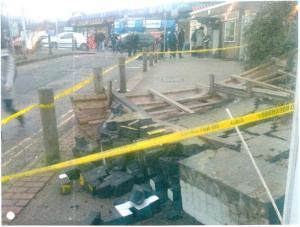Your Carbon Footprint
A company’s Carbon Footprint, Global Warming and environmental issues all come under the umbrella of ‘Safety, Health and Environment’. All of us nowadays, have an environmental policy often as part of our Health & Safety Policy, but how many of you are aware of the statistics or, indeed realise the advantages that reducing your Carbon Footprint can have on your business.
So, this week I thought that I would look at this important subject and tell you of simple ways you can reduce your carbon footprint and save you and your company many £££s at the same time.

So What is a Carbon Footprint?
The term carbon footprint means the total amount of carbon dioxide (CO2) and greenhouse gas (GHG) emissions you (as a person or organisation) are responsible for.
These gases are produced every time energy is used from a fossil fuel source i.e. coal, oil or natural gas.
In other words: When you drive a car, the engine burns fuel which creates a certain amount of CO2, depending on its fuel consumption and the driving distance. (CO2 is the chemical symbol for carbon dioxide).
When you heat your house with oil, gas or coal, then you also generate CO2. Even if you heat your house with electricity, the generation of the electrical power may also have emitted a certain amount of CO2.
When you buy food and goods, the production of the food and goods also emitted some quantities of CO2.
Your carbon footprint is the sum of all emissions of CO2 (carbon dioxide), which were induced by your activities in a given time frame. Usually a carbon footprint is calculated for the time period of a year.
Some facts and figures
Obviously, we all need to travel but here are some figures you may not know –
All the following means of travel add 1kg of CO2 to your personal carbon footprint:
- If your car does 39 miles per gallon and is run on petrol and you drive 3.75 miles
- If your car does 39 miles per gallon and is run on diesel and you drive 3.15 miles
- However, if you travel by bus or train instead you can travel 7 miles
- If you fly in a plane the distance is just 1.375 miles
Other activities that add 1 kg of CO2 to your personal carbon footprint include:
- Operating your computer for 32 hours
- The production of 5 plastic bags
- The production of 2 plastic bottles
- The production of 1/3 of a cheeseburger (yes, the production of each cheeseburger emits 3.1kg of CO2!!)
Why do we need to reduce our carbon footprint?
To slow the rate of climate change.
At present the average person’s carbon footprint in the UK is 9.3 tonnes of CO2.
The average carbon footprint per head needed to keep global temperature change below 2°C is about 3t per head. – Hence the UK still needs to cut its levels by 80%.
Emissions of CO2 and GHGs contribute to climate change and businesses are responsible for nearly half of all these emissions
Other advantages
- Save money by cutting energy bills
- Improve your business’ reputation
- Meet government targets
How can you and your company reduce your carbon footprint?
By minimising energy usage and making many simple, low cost actions can make a significant difference.
Lighting
- Switch lights off in empty rooms
- light only the part of a room where needed
- use natural light where possible
- maintain lighting systems so they work efficiently once calculated, you can also offset the carbon through utilisation of renewable energy or tree planting schemes (offsetting).
Heating
- Keep thermostats at a maximum of 19°C – Did you know that in the 1970s the average temperature in houses in the UK was 14°C for those with central heating and just 12°C for those without. Compared with 22°C in today’s houses!
- leave space around heaters/radiators to let warm air circulate
- do not heat unused space – eg empty rooms, or offices at night or at the weekend when they are closed
- keep doors and windows closed and draught proofed
- maintain heating systems so they can work efficiently.
Reduction/substitution of travel
- Using carbon efficient methods of transport
- replacing car journeys with cycling
- car sharing
- limiting air travel.
- public transport – I regularly use public transport and have found it works out cheaper than driving as well as being less stressful
- replace meetings where everyone has to travel, with online conference calls
Waste/recycling/purchasing
- Reduce the amount of waste you produce
- implement the waste hierarchy and reduce, reuse and recycle.
- select local materials, products, foods and services
- use eco-friendly options where available
- select low energy, easily recyclable goods.
How can you get your employees involved?
Consider their individual practices with regard to:-
- transport – can they car share once a week (reduction of 20% in their footprint)
- what electrical products do they use – are they all needed?
- how much do they throw away? Can any be reduced/reused/recycled/? – The average 8 cubic yard skip costs about £350 but the average cost of what is being thrown away in that skip is £1,500. Also in the UK an average of 13% of all materials delivered to site go into a skip without ever being used!
What are governments doing about it?
The Kyoto Protocol
The Kyoto Protocol sets out binding targets and timetables for 37 industrialized countries and aims to reduce greenhouse gas emissions of those countries. The Protocol entered into force on 16 February 2005 and the UK is committed to sourcing 15% of energy consumed from renewable sources by 2020. As of 2015 8.3% of energy consumed was from renewable energy sources.
Paris Agreement
At the Paris climate conference (COP21) in December 2015, 195 countries adopted the first-ever universal, legally binding global climate deal with the goal of keeping the increase in global average temperature to well below 2°C above pre-industrial levels.
Legislation and guidance
- Climate Change Act 2008
- European Union Emissions Trading Scheme
- Climate Change Levy (General) Regulations 2001
- Greenhouse Gas Emissions Trading Scheme Regulations 2005 as amended
- The Energy Act 2013
- Climate Change (Scotland) Act 2009
- PAS2050:2011 – Specification for the assessment of the life cycle greenhouse gas emissions of goods and services
- Greenhouse Gas (GHG) Protocol – Product Standard Verification
- CRC Energy Efficiency Scheme Order 2013
- Energy Savings Opportunity Scheme (ESOS) 2014
Taunton & Somerset CPD Group at The Exchange House Taunton
Please remember that we now run these CPD events at the Exchange House, 12 – 14 The Crescent, Taunton TA1 4EB on a fortnightly basis
The next of the CPD events is listed below.
As previously requested, if you could let us know whether or not you can attend it would be greatly appreciated. Also, if you would like to give a talk, or know of somebody who would, please contact Jon at [email protected]
Our next Seminar will be on Wednesday 15th May 2019 Could you please arrive by 12:30pm prompt.
Our speaker for this one is Craig Huxley of Triflex (UK) Limited will talk about Intelligent roof protection and living life outside
PLEASE NOTE NEW DATE OF 15th May NOT 8th May
If you haven’t already booked your place, or if you are not on the CPD Seminar mailing list but would like to be please drop Jon an email and he will deal with your request.
As per our last one if you could let Jon know whether or not you can attend within 7 days of receipt of his email, it would be greatly appreciated.
Contact Details [email protected], 07831 714199 or 01458 253682
Update on forthcoming e-courses and other website upgrades
As we reported at the start of the year, Wilkins Safety Group Ltd are soon to be offering e-courses. These should be available on our website from the week commencing 13th May.
Why use online health and safety e-learning?
There are many e-learning benefits: You can drastically cut your risks and improve effectiveness. Staff retention and productivity will increase and safety will improve. It’s that simple.
The health and safety e-learning training courses are dynamic, engaging and very interesting. As the content is interactive your staff will learn quickly, retain more knowledge and enjoy the training.
The self test section means that they get to see how much they have learnt and if necessary, revisit any areas that they have failed. There is an option to print a certificate for each user who has passed which is personalised with their details.
By providing high quality accurate health and safety information to your staff you will build a culture of safety and help increase staff retention, productivity as well as protecting yourself from damaging and expensive legal action.
One of the major e-learning benefits is the fact that the system provides an audit trail which tracks your staff progress and you can make an accurate assessment of their understanding.
How is the training delivered?
The Wilkins Safety Group e-learning system is delivered over the Internet, all you need to access your system is a PC with Internet browser (you will also need your user name and password).
The system is hosted on our secure server. The server carries an SSL certificate and all data is encrypted for maximum security. We manage the server that means that you have no IT worries.
What is the cost of these courses?
Companies will be able to buy credits. Each of these credits will allow 1 allocated person access to 1 course. The cost of these credits will reduce based on the number of credits purchased. See pricing chart below:
| No of Credits | 1-5 | 6-10 | 11-20 | 21-30 | 31-40 | 41-50 | 51-75 | 76-100 | 101-150 | 151-200 | 201-250 |
|---|---|---|---|---|---|---|---|---|---|---|---|
| Cost of Credit | £19.99 | £17.99 | £16.99 | £15.99 | £14.99 | £13.99 | £12.99 | £11.99 | £10.99 | £9.99 | £7.99 |
Below is the list of the first 17 e-courses that should be live next week
- Asbestos Awareness Interactive
- COSHH Interactive
- DSE Equipment
- DSE Workstation Assessment
- Electrical Safety
- Environmental Awareness
- Fire Extinguishers
- Fire Safety Interactive
- Fire warden Interactive
- First Aid
- Food Hygiene
- Food Hygiene Level 2
- Health and Safety Induction Interaction
- Manual Handling
- Protection against effects of Noise
- Risk Assessment
- Stress in the Workplace
We would love to hear any expressions of interest or of any other courses that you would like us to develop.
We are looking at Permits to Work; Slips, Trips and Falls and Working at Height to follow soon after
Live Chat facility
We are also launching a “Live Chat” service on our website.
This should enable us to guide you through our site and answer any Health and Safety questions you may have during your visit. If they cannot be answered immediately, because the appropriate adviser isn’t available at that time, our staff will take your details and question and ensure that you receive an answer ASAP.
Self-employed plumber sentenced
Self-employed plumber sentenced after conducting unregistered gas work
An Essex-based plumber has today been sentenced after carrying out unsafe and unregistered gas work in September 2016.
Basildon Crown Court heard how Andrew Goodchild, of ASG Plumbing and Heating had been served with a Prohibition Notice (PN) by the Health and Safety Executive (HSE) earlier that year for carrying out gas work whilst not being registered with Gas Safe.
Mr Goodchild ignored the requirements of the PN when he removed a gas cooker and pipework from the kitchen and moved a gas boiler, in Leigh-on-Sea in September 2016 leaving it in a dangerous condition. He had not become registered with Gas Safe Register and did not possess the necessary qualifications for carrying out gas work.
Andrew Goodchild of The Maples, Harlow, Essex pleaded guilty to breaching the Prohibition Notice and Regulation 3(3) of the Gas Safety (Installation and Use) Regulations 1998 and was found guilty in a Newton hearing of breaching Regulation 3(1) of the Gas Safety (Installation and Use) Regulations 1998. He has received an 18 month suspended sentence, ordered to carry out 250 hours of unpaid work and pay £3,200 in costs.
Speaking after the hearing, HSE inspector Saffron Turnell said:
“Mr Goodchild showed a clear disregard for the law and put a number of people’s lives at risk. Carrying out gas work is difficult, specialised and potentially very dangerous. It is therefore vital that only registered gas engineers, who are trained and competent, work on gas appliances and fittings.”
Wall collapses on man
GLA Land and Property fined after wall collapses on man in front of wife and children
The land and property arm of the Greater London Authority has today been fined for serious failings in safety management after an advertising hoarding collapsed onto a man in front of his wife and two children.
Southwark Crown Court heard how on 25 January 2014 a family of four were hurrying along a pavement to Catford Station to shelter from a storm when a wall and hoarding was blown onto the father, causing him to lose consciousness and end up hospitalised. The man, 45, suffered facial and skull injuries including a fractured eye socket and had to have a titanium plate inserted into his left cheek area. The whole family including the children, four and nine at the time, remain affected by the incident.
A Health and Safety Execitive (HSE) investigation found that GLA Land Property LTD (GLAP) employed a company to manage and maintain this site. The investigation found that GLAP failed to oversee the contract properly, resulting in the wall not being maintained. The wall developed a crack which weakened, causing the hoarding to act like a sail in strong winds, eventually leading to its collapse.
GLA Land and Property Ltd of Broadway, London, pleaded guilty under Section 3(1) of the Health and Safety at Work etc. Act 1974 and was fined a total of £250,000 and ordered to pay £ £14,653 in costs.
Speaking following the hearing, HSE inspector Ian Shearring said:
“A set of simple arrangements to inspect and maintain the wall would have picked up on the imminent danger to any passer-by. Instead, a whole family was traumatised by seeing the father sustaining serious injuries from being struck by hoarding as it collapsed. It was only a matter of luck that no one was killed on the day outside a busy station.”
Remember
Unlike other organisations who send out newsletters giving you a little titbit of information, then stating that if you want to follow the full link or read the full story or get more information you must pay to subscribe to their service.
- Our newsletter service is FREE,
- The links we supply are FREE,
- The helpline advice is FREE.

If you find this newsletter service of use and you think others might also find it useful, then kindly pass it on and ask them to subscribe for free, so they can continue to receive it in their own right.
Also contact us if you have a particular health and safety subject or question you would like covered
If you have any queries on any health and safety matter, please contact Jon Wilkins on 01458 253682 or by email on [email protected]


